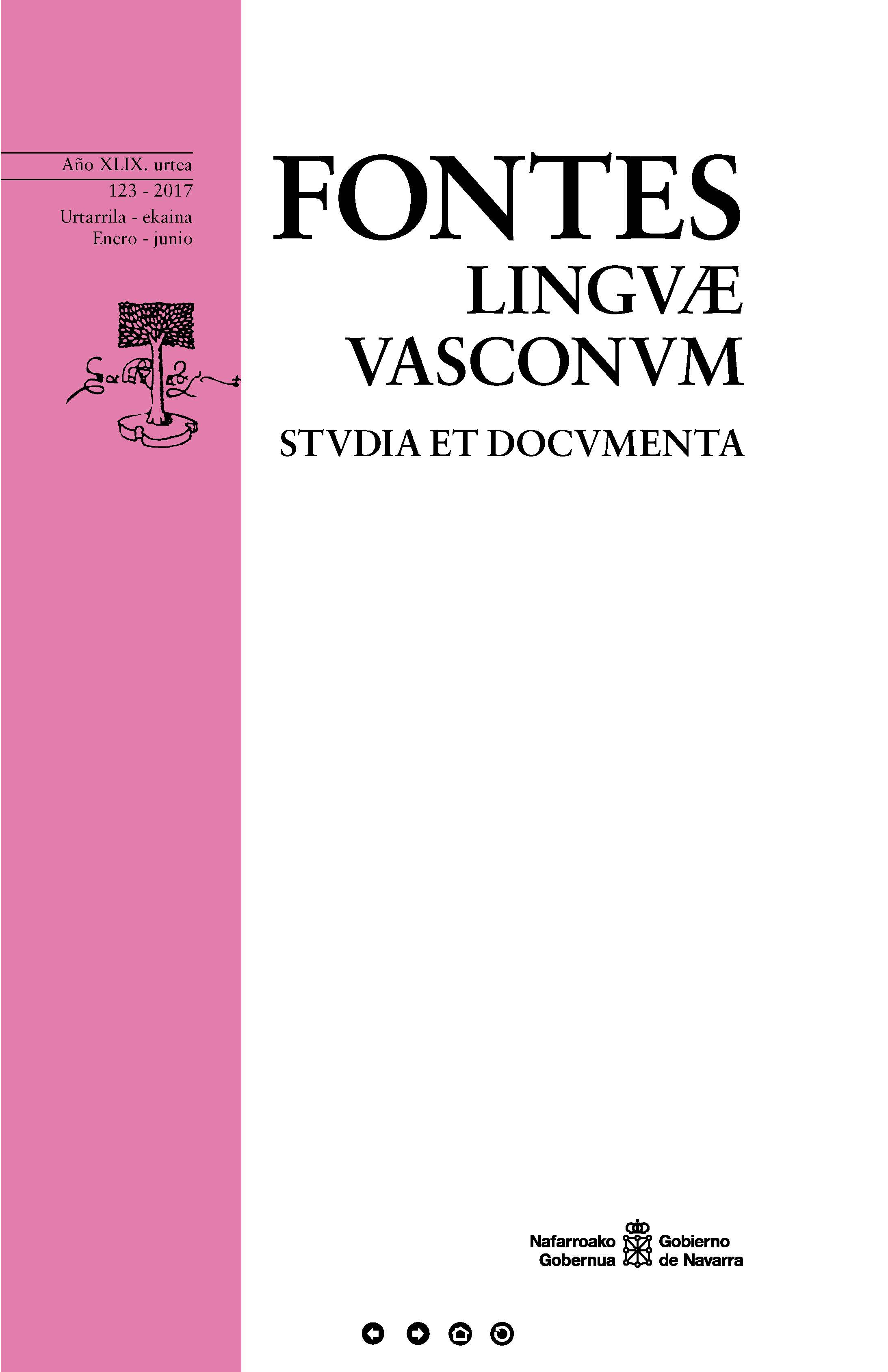Euskara Bariazioan / Basque in Variation (BiV): lehen urratsak [Basque in Variation (BiV): first steps]
Abstract
The aim of this work is to explain the nature of BiV database. BiV is an online database on Basque morphosyntactic properties that have cross-dialectal variation. It stores the data obtained from questionnaires and displays the distribution of the variation. It also provides the description of each property and illustrative examples. The aerial view shows, on the one hand, that some properties have the same or very similar distribution as that attributed to them in dialectological works. On the other hand, it reveals that a few properties take a wider area than the one expected. Finally, it shows that certain properties have a clear division between two zones: North v. South or East v. West.
##about.statistics##
References
Badihardugu Euskara Elkartea. (2003). Euskal Herriko Ahotsak. Hemendik hartua: https://www.ahotsak.eus/proiektuak/euskal-herriko-ahotsak
Comrie, B., Haspelmath, M. & Bickel B. (2015). The Leipzig Glossing Rules. Hemendik hartua: https://www.eva.mpg.de/lingua/pdf/Glossing-Rules.pdf
Dryer, M. S. & Haspelmath, M. (arg.). (2013). The World Atlas of Language Structures (WALS). Leipzig: Max Planck Institute for Evolutionary Anthropology. Hemendik hartua: http://wals.info/
Euskaltzaindia. (2008-2016). Euskararen Herri Hizkeren Atlasa (EHHA). Bilbo: Euskaltzaindia. Hemendik hartua: http://ww.euskaltzaindia.fr/index.php?option=com_content&view=article&id=565&Itemid=466&lang=eu
Fernández, B., Berro, A., Orbegozo, I., Arriortua, A. & Landa, J. Euskara Bariazioan/Basque in Variation (BiV). UPV/EHU. Hemendik hartua: http://basdisyn.net/Bas&Be/biv/?
Hualde, J. I. (2016). On Basque dialects. In B. Fernández & J. Ortiz de Urbina (arg.), Microparameters in the grammar of Basque (15-35 orr.). Amsterdam/Philadelphia: John Benjamins. https://doi.org/10.1075/lfab.13.02hua
Uria, L. & Etxepare, R. Basyque, Euskal sintaxiaren datu-basea. IKER UMR 5478 (CNRS) eta IXA Taldea. Hemendik hartua: http://ixa2.si.ehu.es/atlas2/index.php?lang=eu
Koopman, H. (ed.). (2009). Syntactic Structures of the World’s Languages (SSWL). Hemendik hartua: http://SSWL.railsplayground.net/ (azken bisita 2017-03-05).
Kortmann, B. & Lunkenheimer, K. (arg.). (2013). The Electronic World Atlas of Varieties of English. Leipzig: Max Planck Institute for Evolutionary Anthropology. Hemendik hartua: http://ewave-atlas.org
Mejías Bikandi, E. (1999). Unaccusative and antipassive constructions in Basque and Spanish. In J. Franco, A. Landa & J. Martín (arg.), Grammatical analyses in Basque and Romance linguistics. Papers in honor of Mario Saltarelli, (165-177 orr.). Amsterdam/Philadelphia: John Benjamins. https://doi.org/10.1075/cilt.187.10mej
Oihartzabal, B., Epelde, I. & Salaberria, J. (2009). Norantz proiektua. Hemendik hartua: http://norantz.org/
Polinsky, M. (2013). Antipassive constructions. In M. S. Dryer & M. Haspelmath (arg.), The World Atlas of Language Structures (wals). Leipzig: Max Planck Institute for Evolutionary Anthropology. Hemendik hartua: http://wals.info/chapter/108
Uria, L. & Etxepare, R. (2011), Basyque: aplicación para el estudio de la variación sintáctica. Revista Linguamática, 3 (1), 35-44.
Uria, L. & Etxepare, R. (2012). Hizkeren arteko aldakortasun sintaktikoa aztertzeko metodologiaren nondik norakoak: Basyque aplikazioa, Lapurdum, 16, 117-135. https://doi.org/10.4000/lapurdum.2393
Videgain, Ch. & Aurrekoetxea, G. (1993). Euskal Herriko hizkuntza atlasa: galdesorta – cuestionario – questionnaire. Euskera, 38 (2. aldia), 529-647.
Zuazo, K. (2004). Euskalkiak, herriaren lekukoak. Donostia: Elkar.
Zuazo, K. (2008). Euskalkiak, euskararen dialektoak. Donostia: Elkar.
Zuazo, K. (2010). El euskera y sus dialectos. Irun: Alberdania.
Zuazo, K. (2013). The dialects of Basque. Reno: University of Nevada.
Zuazo, K. (2015). Euskalkiak. Interneten eskuragarri http://euskalkiak.eus/
Copyright (c) 2017 Ane Berro Urrizelki, Beatriz Fernández Fernández, Itziar Orbegozo Arrizabalaga

This work is licensed under a Creative Commons Attribution-NonCommercial 4.0 International License.







